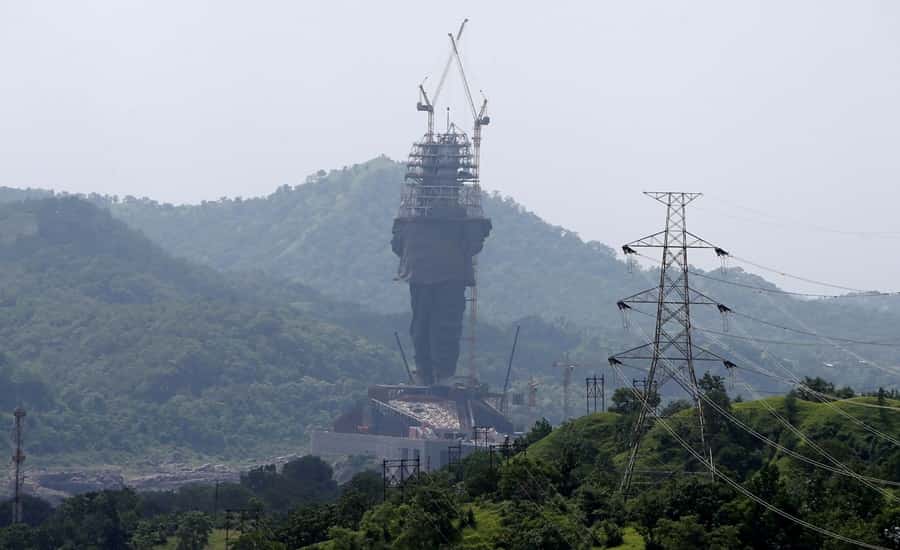The Statue of Unity, a colossal tribute to Sardar Vallabhbhai Patel, holds a significant place in India’s architectural and historical landscape. This towering statue, standing at a height of 182 meters, symbolizes the unity and integration of the nation. However, the journey from its conceptualization to completion was fraught with controversies, opposition, and debates that reflected the diverse perspectives on its construction.

Genesis of the Project
The seeds of the Statue of Unity project were sown when Narendra Modi, then the Chief Minister of Gujarat, proposed the idea on October 7, 2010. This announcement marked the beginning of a project intended to pay homage to Sardar Patel, often hailed as the ‘Iron Man of India’ for his instrumental role in unifying the princely states after independence. The proposal, titled “Gujarat’s tribute to the nation,” aimed to immortalize Patel’s legacy in the form of an imposing statue.
Opposition and Controversies
Despite the noble intentions behind the project, it faced vehement opposition from various quarters. Tribal communities and farmers residing in the vicinity of the proposed statue site raised concerns about displacement, environmental impact, and the allocation of resources. These grievances translated into organized protests, supported by politicians from opposition parties. The controversy surrounding the displacement of local communities and the environmental impact became a focal point of public discourse.
The Statue of Unity Movement
In response to the opposition, the Sardar Vallabhbhai Patel Rashtriya Ekta Trust (SVPRET) initiated the Statue of Unity Movement in 2013. This movement aimed to collect iron for the statue by encouraging farmers to donate their used farming instruments. The symbolic act of donating iron aimed to involve the local communities in the construction process and address some of the concerns raised by the opposition. The movement also included events like the “Run For Unity” marathon held in 2013 in Surat and Vadodara to build public support.
Collection of Iron and Foundation Construction
The Statue of Unity Movement successfully collected 135 metric tonnes of scrap iron by 2016. This iron, donated by farmers, was then processed, with approximately 109 tonnes used in constructing the foundation of the statue. This unique approach to material resourcing became a noteworthy aspect of the project, showcasing a blend of community involvement and symbolism.
Design and Construction
The design of the statue was conceptualized by the renowned sculptor Ram Vanji Sutar, a recipient of the Padma Shri and Padma Bhushan awards. The statue itself was divided into five zones, three of which were accessible to tourists, while the remaining two were reserved for officials and engineers. These zones included a museum, a garden, and a viewing gallery, providing visitors with a comprehensive experience of Sardar Patel’s life and contributions.
Environmental Concerns and Long-term Impact
Experts predicted that the statue would undergo a natural aging process, turning green in color over the next century due to factors such as acid rain, pollution, and environment-aided chemical reactions. This revelation sparked discussions about the long-term maintenance and preservation of the statue, with environmentalists raising concerns about the impact of such a colossal structure on the surrounding ecosystem.
Completion and Inauguration
Despite the controversies and challenges, the construction of the Statue of Unity was completed in 2018. On October 31 of the same year, Prime Minister Narendra Modi inaugurated the statue in a grand ceremony. The unveiling marked a momentous occasion, symbolizing the culmination of years of planning, execution, and debates.
Conclusion
The Statue of Unity stands today as a testament to Sardar Vallabhbhai Patel’s legacy and India’s unity in diversity. While it has become a prominent tourist attraction and a source of national pride, its journey from conception to completion was marked by controversies and opposition. The diverse perspectives surrounding the project underscore the complex nature of balancing monumental tributes with the concerns of local communities and environmental sustainability. The Statue of Unity, with its towering presence, continues to be a subject of admiration, critique, and ongoing dialogue about the interplay between history, culture, and public sentiment.
Also Read:
- Interesting Facts About The Statue Of Unity
- Best Time to Visit Statue of Unity
- How to Reach Statue Of Unity
Popular Tour Packages
